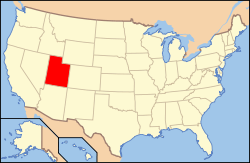Denver and Rio Grande Western Depot (Salt Lake City)
Salt Lake City Denver and Rio Grande Western Railroad Depot | |||||||||||||||||||||||||||||||||||
|---|---|---|---|---|---|---|---|---|---|---|---|---|---|---|---|---|---|---|---|---|---|---|---|---|---|---|---|---|---|---|---|---|---|---|---|
| Former Amtrak inter-city rail station | |||||||||||||||||||||||||||||||||||
 Rio Grande Depot | |||||||||||||||||||||||||||||||||||
| Location |
300 South Rio Grande Street Salt Lake City, Utah United States | ||||||||||||||||||||||||||||||||||
| Owned by | State of Utah | ||||||||||||||||||||||||||||||||||
| Tracks | None remaining | ||||||||||||||||||||||||||||||||||
| Construction | |||||||||||||||||||||||||||||||||||
| Structure type | At-grade | ||||||||||||||||||||||||||||||||||
| Other information | |||||||||||||||||||||||||||||||||||
| Station code | SLC | ||||||||||||||||||||||||||||||||||
| History | |||||||||||||||||||||||||||||||||||
| Opened | 1910 | ||||||||||||||||||||||||||||||||||
| Closed | May 1999 (for passenger rail service) | ||||||||||||||||||||||||||||||||||
| Services | |||||||||||||||||||||||||||||||||||
| |||||||||||||||||||||||||||||||||||
|
Denver and Rio Grande Railroad Station | |||||||||||||||||||||||||||||||||||
  | |||||||||||||||||||||||||||||||||||
| Coordinates | 40°45′46″N 111°54′16″W / 40.76278°N 111.90444°WCoordinates: 40°45′46″N 111°54′16″W / 40.76278°N 111.90444°W | ||||||||||||||||||||||||||||||||||
| Area | 2 acres (0.81 ha) | ||||||||||||||||||||||||||||||||||
| Built | 1910 | ||||||||||||||||||||||||||||||||||
| Architect | Henry S. Schlachs | ||||||||||||||||||||||||||||||||||
| Architectural style | Renaissance Revival, Beaux-Arts | ||||||||||||||||||||||||||||||||||
| NRHP Reference # | 75001815[1] | ||||||||||||||||||||||||||||||||||
| Added to NRHP | 25 September 1975 | ||||||||||||||||||||||||||||||||||
The Denver and Rio Grande Western Depot, commonly referred to as the Rio Grande Depot, is a former train station on the western edge of downtown Salt Lake City, Utah, United States. It is currently home to the Division of Utah State History and the Utah Department of Heritage & Arts, as well as the Rio Gallery.
History
The depot was constructed by the Denver and Rio Grande Western Railroad in 1910 at a cost of US$750,000.[2] The depot was the main jewel of the Denver and Rio Grande Western Railroad, and was designed by Chicago architect Henry Schlacks, who was best known in Chicago for his design of churches, but had also designed the Denver and Rio Grande Depot in Grand Junction, Colorado, for the railroad.[3] It was specifically intended to surpass the nearby Salt Lake City Union Pacific Depot, which had been built the previous year for US$300,000.[2] Schlacks's relationship with D&RG was fraught with antagonism, mainly over his pay, which led to delay in the depot's construction. One interesting, and ironic, point was that Schlacks's brother was D&RG's vice president.[3] The depot was built with elements of Renaissance Revival and Beaux Arts. The high-arched windows at the center were originally installed with green glass to keep the waiting area cool. The depot included a barber shop, a restaurant, a men's smoking room and a women's lounge. There was also a telegraph office and a souvenir/snack bar. The depot opened Salt Lake City to a new influx of immigrants. The depot was also a central point in shipping soldiers off to war in both World War I and World War II. The rise of highway auto travel in the 1950s struck a blow to rail travel and service at the depot dwindled.[3] The depot was listed on the National Register of Historic Places in 1975. The State of Utah purchased the depot in 1977 for US$1 and the building is currently home to the Utah State Historical Society and its research center, the Utah Department of Heritage & Arts, as well as the Rio Gallery.[2][4]
Amtrak
From 1986 to 1999, the depot served as Salt Lake City's Amtrak station, replacing the Union Pacific Depot. It was served by the California Zephyr, Desert Wind, and Pioneer trains, with the latter two having been discontinued in 1997.[5][6] The California Zephyr runs once daily between Chicago, Illinois, and Emeryville, California (in the San Francisco Bay Area). The former Desert Wind ran daily from Chicago to Los Angeles, and the former Pioneer ran daily Chicago to Seattle. By 1999, Amtrak had moved to the Salt Lake City Intermodal Hub,[7] after which the tracks near the depot were permanently removed.
See also
References
- ↑ National Park Service (2010-07-09). "National Register Information System". National Register of Historic Places. National Park Service.
- 1 2 3 Haddock, Marc (19 Apr 2010). "All aboard! Rio Grande Depot turns 100 this year: Former Salt Lake train station now houses restaurant, museum ... and ghost?". Deseret News. Salt Lake City: Deseret Digital Media. Retrieved 9 Jan 2014.
- 1 2 3 Johnson, Brandon (Summer 2010). "One Building's Life: A History of Salt Lake City's Denver and Rio Grande Depot". Utah Historical Quarterly. 78 (3): 196.
- ↑ "Utah Division of State History: Contact State History". utah.gov. State of Utah. Retrieved 9 Jan 2014.
- ↑ "Amtrak National Timetables". timetables.org. Amtrak. 26 Oct 1986. p. 8. Retrieved 9 Jan 2014.
- ↑ "Amtrak National Timetable: Spring/Summer 1999". timetables.org. Amtrak. 16 May 1999. p. 17. Retrieved 9 Jan 2014.
- ↑ "Amtrak Timetable: Fall 1999/Winter 2000". timetables.org. Amtrak. 31 Oct 1999. p. 17. Retrieved 9 Jan 2014.
Further reading
- Johnson, Brandon. "One Building's Life: A History of Salt Lake City's Denver and Rio Grande Depot," Utah Historical Quarterly (2010) 78#3 pp 196–217.
External links
![]() Media related to Denver and Rio Grande Western Depot (Salt Lake City) at Wikimedia Commons
Media related to Denver and Rio Grande Western Depot (Salt Lake City) at Wikimedia Commons
- Salt Lake City Amtrak Station, with former Rio Grande & Union Pacific Stations (USA RailGuide -- TrainWeb)
- Utah State Historical Society - Rio Grande Depot

